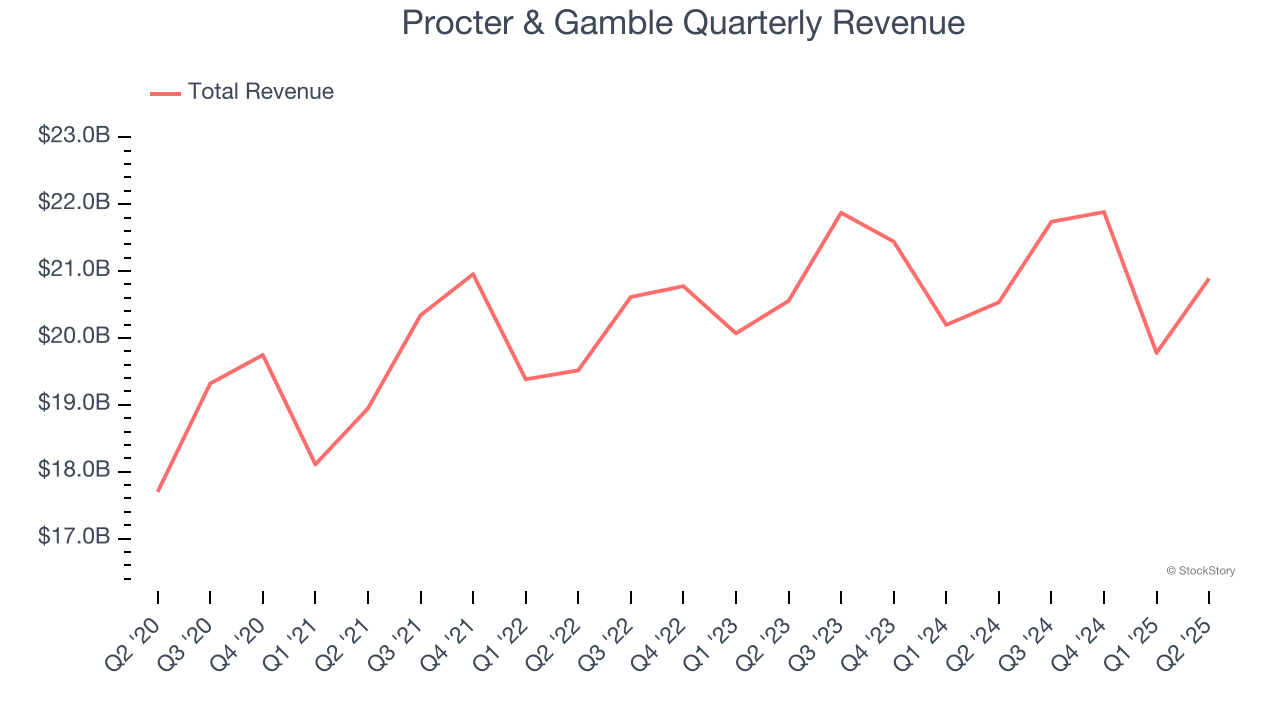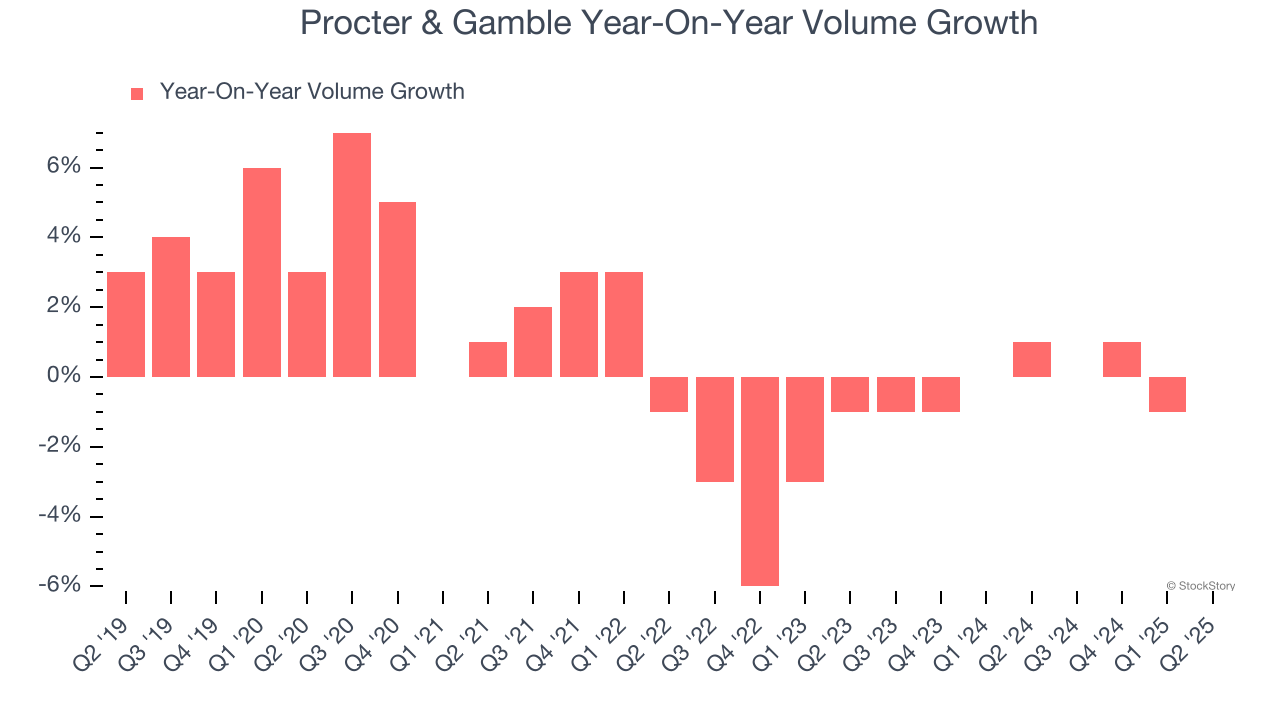
Consumer products behemoth Proctor & Gamble (NYSE:PG) met Wall Street’s revenue expectations in Q2 CY2025, with sales up 1.7% year on year to $20.89 billion. Its non-GAAP profit of $1.48 per share was 4.1% above analysts’ consensus estimates.
Is now the time to buy Procter & Gamble? Find out by accessing our full research report, it’s free.
Procter & Gamble (PG) Q2 CY2025 Highlights:
- Revenue: $20.89 billion vs analyst estimates of $20.85 billion (1.7% year-on-year growth, in line)
- Adjusted EPS: $1.48 vs analyst estimates of $1.42 (4.1% beat)
- Free Cash Flow Margin: 19.1%, down from 24.2% in the same quarter last year
- Organic Revenue rose 2% year on year, in line with the same quarter last year
- Sales Volumes were flat year on year (1% in the same quarter last year)
- Market Capitalization: $368.4 billion
“We grew sales and profit in fiscal 2025 and returned high levels of cash to shareowners in a dynamic, difficult and volatile environment,” said Jon Moeller, Chairman of the Board, President and Chief Executive Officer.
Company Overview
Founded by candle maker William Procter and soap maker James Gamble, Proctor & Gamble (NYSE:PG) is a consumer products behemoth whose product portfolio spans everything from facial tissues to laundry detergent to feminine care to men’s grooming.
Revenue Growth
Examining a company’s long-term performance can provide clues about its quality. Any business can put up a good quarter or two, but many enduring ones grow for years.
With $84.28 billion in revenue over the past 12 months, Procter & Gamble is one of the most widely recognized consumer staples companies. Its influence over consumers gives it negotiating leverage with distributors, enabling it to pick and choose where it sells its products (a luxury many don’t have). However, its scale is a double-edged sword because it’s harder to find incremental growth when your existing brands have penetrated most of the market. For Procter & Gamble to boost its sales, it likely needs to adjust its prices, launch new offerings, or lean into foreign markets.
As you can see below, Procter & Gamble’s sales grew at a sluggish 1.7% compounded annual growth rate over the last three years as it failed to grow its volumes. We’ll explore what this means in the "Volume Growth" section.

This quarter, Procter & Gamble grew its revenue by 1.7% year on year, and its $20.89 billion of revenue was in line with Wall Street’s estimates.
Looking ahead, sell-side analysts expect revenue to grow 2.9% over the next 12 months, similar to its three-year rate. While this projection indicates its newer products will fuel better top-line performance, it is still below average for the sector. At least the company is tracking well in other measures of financial health.
Unless you’ve been living under a rock, it should be obvious by now that generative AI is going to have a huge impact on how large corporations do business. While Nvidia and AMD are trading close to all-time highs, we prefer a lesser-known (but still profitable) stock benefiting from the rise of AI. Click here to access our free report one of our favorites growth stories.
Volume Growth
Revenue growth can be broken down into changes in price and volume (the number of units sold). While both are important, volume is the lifeblood of a successful staples business as there’s a ceiling to what consumers will pay for everyday goods; they can always trade down to non-branded products if the branded versions are too expensive.
To analyze whether Procter & Gamble generated its growth from changes in price or volume, we can compare its volume growth to its organic revenue growth, which excludes non-fundamental impacts on company financials like mergers and currency fluctuations.
Over the last two years, Procter & Gamble’s quarterly sales volumes have, on average, stayed about the same. This stability is normal as the quantity demanded for consumer staples products typically doesn’t see much volatility. The company’s flat volumes also indicate its average organic revenue growth of 2.9% was generated from price increases.

In Procter & Gamble’s Q2 2025, year on year sales volumes were flat. This result was more or less in line with its historical levels.
Key Takeaways from Procter & Gamble’s Q2 Results
Revenue was in line, but it was encouraging to see Procter & Gamble beat analysts’ EPS expectations this quarter. On the other hand, its EBITDA missed and its gross margin fell slightly short of Wall Street’s estimates. Overall, this was a mixed quarter. The stock remained flat at $158.42 immediately following the results.
Is Procter & Gamble an attractive investment opportunity at the current price? What happened in the latest quarter matters, but not as much as longer-term business quality and valuation, when deciding whether to invest in this stock. We cover that in our actionable full research report which you can read here, it’s free.
